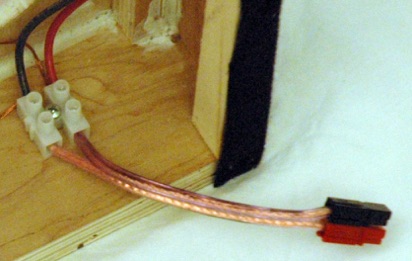After working out a system to connect Free-mo style train modules, it turned out to be the same as one developed by Ron Wm. Hurlbut, and others, with minor variations. The rule is that facing the end plate of any module (from outside the module) connect the Red pigtail to the Right hand rail of the track. Black goes to the left.
Red on the right - facing the end of a module means that if you turn around to look at the module coming to meet it should also have red on the right, and (because you turned around) the right rail will meet the left, the OPPOSITE, rail of the first module. In this system the red on the right will always meet the black on the left of the next module.
I will note here that this cross-wired arrangement is the only method that will mate consistently in a system where either face of the module may be considered the front. Straight through wiring can work, but the colors will not match consistently. Trust me on this - or work it out for yourself...
Anyway, Non-polarized Anderson PowerPole Connectors are ideal for this because each single wire connector can mate with any other. A pair of individual Powerpoles clipped together into a multi-pole plug in an over/under fashion will always cross wires, red to black, when connected to an identical plug . (They become traditionally polarized, red to red, black to black, when hooked together side-by-side).
The universal nature of PowerPoles makes them ideal for quick repairs in the field. A couple of my modules had reversed track feeds. Reversing them in place took only seconds by pulling the multi-plugs apart and hooking them up "wrong". (I marked the lead with yellow tape to remind me to fix the colors later)
Quick disconnecting connectors are great for testing during setup, because isolating any module is a snap. Literally.
Installing Powerpoles can be tricky. The $30 or so for the official crimper is a good investment.
About terminal strips:
It's been noted by some that terminal strips aren't needed once using the PowerPoles or other connectors. I think it is wise to use them anyway because:
-
 Terminals are universal. Not everyone I ever meet will have PowerPoles. But they will have wire.
Terminals are universal. Not everyone I ever meet will have PowerPoles. But they will have wire. -
 Things are never complete. Terminals make great places to add in fixit jumpers with few tools in the rush of setup.
Things are never complete. Terminals make great places to add in fixit jumpers with few tools in the rush of setup. -
 Things pull. Terminals screwed to end plates are really well anchored. A yank on a jumper tied to a terminal strip will not remove all wiring from your module.
Things pull. Terminals screwed to end plates are really well anchored. A yank on a jumper tied to a terminal strip will not remove all wiring from your module. -
 Things break. Terminals give you a starting place from which to fix them. If you carry extra pigtails with plugs on them, you can replace them at the terminals, not try to fix them in the field.
Things break. Terminals give you a starting place from which to fix them. If you carry extra pigtails with plugs on them, you can replace them at the terminals, not try to fix them in the field.
I have adopted the white "european style" strips available in any Radio Shack. (See the Photo Above). They are sold as a long 12 terminal block, but become shorter terminal blocks with the swift application of a razor knife or Xuron cutter. They are designed to clamp directly to the stripped wire, so they cut costs and save the fuss and bother of crimp on terminals. They mount best with #6 pan head screws through the holes down the middle. You will need to stock a small (aprox. 1/8") flat screwdriver in your kit to tighten the terminals.
Don't use small terminal blocks for large wire or you will hate yourself when you find yourself trying to put three wires into a hole barely big enough for one, all while standing on your head.
Kevin Hunter



